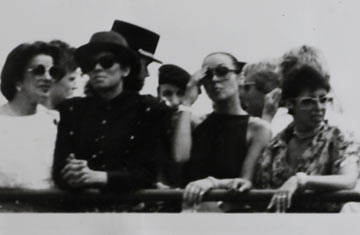
East Germany's Stasi secret police had Michael Jackson under surveillance when he visited West Berlin in 1988, snapping this photo of a man they thought was the pop star (front row, second from left) but has since been revealed as a look-alike.
UPDATED: Aug. 5, 2009, 12:45 P.M.
Since this story was published, it has emerged that the photo in Michael Jackson's Stasi file showing him at the Berlin Wall is actually a shot of a look-alike, hired by a German TV station and good enough to fool East Germany's secret police.
Since the death of Michael Jackson on June 25, the pop star's life and history have become the subject of intense scrutiny. Now we can add a new item to the pile of Jackson resources: his Stasi file.
According to a report from the Stasi, the East German secret police, that has recently come to light, on June 18, 1988, at precisely 2:52 p.m., several cars arrived at Checkpoint Charlie on the West Berlin side of the Berlin Wall, and a handful of passengers emerged. One of them was Jackson.
The King of Pop was accompanied by two West German TV crews and an unidentified woman described in the report as "approximately 25 years old, 165 cm tall, slim figure." The TV crews filmed Jackson at Checkpoint Charlie, and three minutes later he and his entourage climbed the stairs to the viewing platform and peered into the East. A photograph taken from the East Berlin side and pasted into the two-page report in the Stasi file shows Jackson in a tight-fitting dark jacket, his hands clasped, and wearing sunglasses and a hat. Next to him is the mystery woman in dark sunglasses and a sleeveless dress. A TV microphone dangles on the right-hand side of the photo.
As it turns out, the man at the Berlin Wall was not the King of Pop, but a look-alike hired by the German television channel SAT 1 for a broadcast that day. Since the reclusive Jackson refused to go out in public in West Berlin, Sat1 reporters decided to hire their own double and see how Berliners reacted. They hired limousines and body guards, fooling the public, local media, and, as we now know, the notorious Stasi secret police. The coup was so successful that it worked again 20 years later when Jackson's Stasi file, and the infamous pictures, emerged. This time SAT 1 nearly fell for its own prank. "We certainly would have fallen for the Stasi pictures but by chance a colleague was on duty who happened to be at the shooting of the Jackson double back in 1988," said Diana Schardt, spokeswoman for SAT 1 television. "We almost went with it, but then cleared it up."
Jackson gave a concert that day in West Berlin as part of a three-day festival on the West Berlin side of the Wall. He was touring to promote his album Bad and was joined on the bill that day by Pink Floyd. And judging by the meticulous notes the agent kept, the Stasi considered it one of the most threatening moments for the security of the now defunct East German state.
For weeks, the East Germans had been trying to figure out a way to prevent Jackson's moonwalk through West Berlin from becoming political dynamite for East German youth. These were the days of Perestroika, when the Soviet Union's iron grip on Eastern Europe was slipping and Soviet President Mikhail Gorbachev was becoming a source of hope for reformers in the East and the West. The Stasi was determined not to repeat the events of the year before, when East Germans amassed at the Wall to listen to a concert by Genesis, David Bowie and Eurythmics in West Berlin. As the bands played, the East Berlin crowds chanted "Gorby, Gorby" and "Down with the Wall," until they were silenced by East German security forces who beat them with batons and made scores of arrests. A short time later, U.S. President Ronald Reagan gave his now famous speech at the Brandenburg Gate, calling on Gorbachev to "tear down this wall."
Details in the Stasi's report on Jackson suggest that the Western promoter, the concert's sponsor and Jackson's management were more than willing to accommodate the East Germans' concerns. In the minutes of a preparatory meeting of Stasi officials, dated May 4, 1988, the Stasi notes discussions that it was having with the head of the West German company that was organizing the concert. The names are blacked out in the report. According to the report, the organizer "together with Jackson's management is willing to build the stage at such a height that it is not visible from Unter den Linden" — the boulevard on the eastern side of the Brandenburg Gate — "and to position the speakers appropriately." The plan also involved broadcasting the Jackson concert in a stadium in East Berlin with a two-minute delay, so the East Germans could replace the live performance with a videotape of a previous performance should Jackson make any undesirable political comments.
